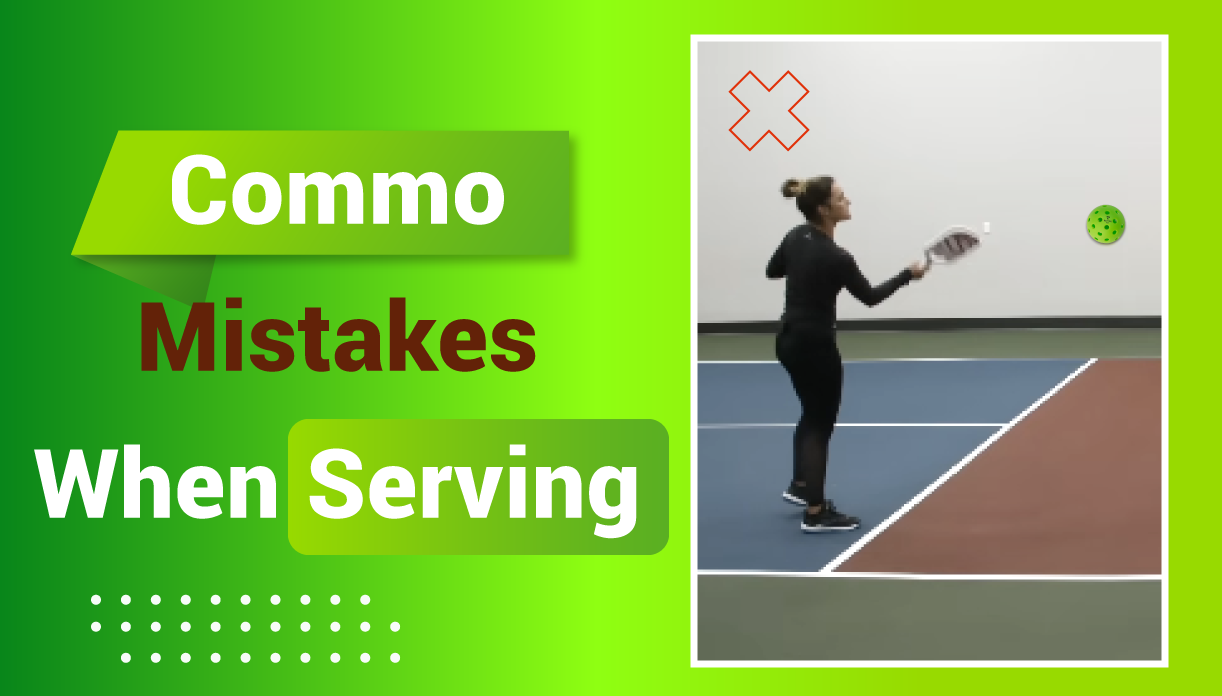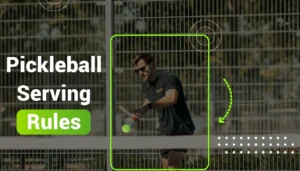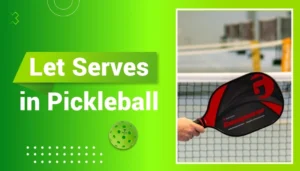Ever lined up for a pickleball serve, feeling confident, only to hear someone shout, “Fault!”? Yeah, I’ve been there. Serving might seem simple at first glance, but it’s actually the key to controlling the game.
Whether you’re new to pickleball or just looking to improve, understanding the pickleball serving rules is essential to mastering this sport.
But don’t worry—I’m here to break it all down. By the end of this, you’ll know exactly what makes a legal serve and how to make yours the best it can be.
Ready to serve like a pro? Let’s dive in!13 Indoor Pickleball Rules: Avoid Your Mistakes
What Makes a Legal Pickleball Serve?
Before we get fancy with serving strategies, let’s nail down the basics. These are the core rules every pickleball player needs to know to serve legally.
- Underhand Rule: In pickleball, the serve must be underhand. That means your arm must be moving upward when the paddle contacts the ball. No overhand smashes allowed!
- Contact Point: When you hit the ball, it must be below your waist. So, no hitting it when it’s up high. Imagine a line at your belly button—that’s the highest point you can serve from.
- Foot Placement: At least one foot has to stay behind the baseline when you serve, and you can’t step into the court or jump before you make contact with the ball. Keep those feet grounded!
- Diagonal Serve: Always serve diagonally across the net to the opposite service box, just like in tennis. If the ball lands in the wrong spot, it’s a fault.
The Two Types of Pickleball Serves: Volley vs. Drop Serve
Pickleball offers a couple of ways to serve, and each one has its perks.
- Volley Serve: This is the traditional method where you hit the ball before it touches the ground. It’s all about timing—holding the paddle in your dominant hand, tossing the ball up with the other, and swinging from below. You’ll see this serve used most often by pros because it can pack a lot of power and speed.
- Drop Serve: Newer to the game but easier to master, the drop serve lets you bounce the ball before hitting it. This makes it perfect for beginners or anyone looking to mix things up. Since the ball bounces before the serve, you don’t have to worry about the upward motion or keeping the ball below your waist. Just drop the ball and let gravity do its thing!
Which one should you use?
- The volley serve is great for power, but the drop serve gives you more control, especially when adding spin. Both are totally legal, so feel free to experiment with both styles and see which one feels best for you!
Common Mistakes When Serving (And How to Avoid Them)

I’ve made plenty of mistakes while learning to serve, and chances are, you’ll encounter these too. But let’s help you avoid the most common pitfalls right from the start!
- Foot Faults: One of the most common errors is stepping on or over the baseline while serving. To avoid this, make sure to stand a few inches back from the line, so you won’t accidentally cross it during your swing.
- Serving Too High: If you strike the ball above your waist, it’s a fault. Always aim to hit the ball just below the waistline to stay safe.
- Forgetting to Call the Score: In pickleball, you must call out the score before every serve. It’s easy to forget, but it’s part of the rules. Just remember: your score, your opponent’s score, and (in doubles) the server number.
- Serving Into the Kitchen: If your serve lands in the kitchen (the non-volley zone), it’s a fault. So make sure you give the ball enough height and power to clear the kitchen line.
Serving in Doubles vs. Singles: What’s the Difference?
Serving works a little differently depending on whether you’re playing singles or doubles.
- Doubles Serving:
- In doubles, the score is called using three numbers: your team’s score, your opponent’s score, and whether you’re the first or second server (1 or 2).
- The server on the right side of the court always starts, and players switch sides after each point.
- The first-server exception: At the start of the game, the first team to serve only gets one server before handing the serve to the other team. That’s why you’ll often hear “0-0-2” at the beginning of a match.
- Singles Serving:
- In singles, things are simpler. You only call two numbers (your score and your opponent’s).
- If your score is even, you serve from the right side of the court. If it’s odd, you serve from the left.
If you want to know about Let Serve, check this out.
How to Rotate Servers in Doubles (Without Getting Confused!)
Let’s face it—rotating servers in doubles can be confusing, especially when you’re just starting out. But once you get the hang of it, it’s easy!
- The first server serves until they lose a point (commit a fault).
- After that, the second server gets their turn. Only when both servers have lost their rally does the serve go to the other team.
- If your team scores a point, the server stays in but switches sides with their partner.
Tip: The player on the right side of the court always serves first after each side-out, making it easier to track who serves when.
Mastering the Serve: Quick Tips to Improve Your Game

If you want to improve your serve quickly, here are a few tips that have helped me along the way.
- Serve Deep to Keep Your Opponent at Bay: A deep serve pushes your opponent toward the baseline, giving you more time to react to their return and keeping them from rushing the net.
- Mix It Up: Vary your serve’s speed, placement, and spin to keep your opponent guessing. A predictable serve is easy to return!
- Focus on Consistency: Don’t try to hit an ace every time. The goal is to get the ball in play. As you become more comfortable, you can start adding power and spin.
- Practice Makes Perfect: Serve practice is crucial. Try setting up targets on the court to aim for during practice. It’s a fun way to improve your accuracy!
The Two-Bounce Rule: What It Means for Your Serve
The Two-Bounce Rule is a unique aspect of pickleball and something that makes the game so strategic.
Here’s how it works:
- After you serve, the receiving team must let the ball bounce once before returning it.
- Then, you must let the return bounce once on your side before hitting it back.
- After the ball has bounced once on each side, the rally is open, and players can volley or hit the ball after it bounces.
This rule helps to slow the game down and prevent teams from rushing the net right away, making for longer, more exciting rallies.
Fun Ways to Practice Your Serve and Build Confidence
Want to practice your serves and get better in no time? Try these fun drills!
- Serve Challenge: Set up targets on the court and aim to hit them with your serve. Give yourself points for accuracy!
- The “Depth Drill”: Practice serving deep by aiming for the back of the service box. This drill will help you develop better control and power.
- Serve and Return Game: Grab a friend and practice serving and returning. The goal is to get used to the Two-Bounce Rule while working on your serve placement.
Let’s Get You Serving Like a Pro!
Now that you know the ins and outs of pickleball serving rules, you’re ready to hit the court with confidence! Remember, mastering the serve takes time, but with these tips and a little practice, you’ll be serving like a pro in no time. So, grab your paddle, hit the court, and let’s see those serves fly!
Feel free to share your favorite serving tips in the comments below—I’d love to hear what’s working for you. Until next time, happy pickling! 🏓
FAQs About Pickleball Serving Rules
1. What is the basic rule for serving in pickleball?
The serve must be underhand, hit below the waist, and go diagonally across the court into the opposite service box. The paddle must move in an upward arc.
2. Can I use a drop serve instead of a volley serve?
Yes! The drop serve is totally legal and allows you to hit the ball after it bounces. It’s easier for beginners and great for adding spin to your serve.
3. What happens if my serve hits the net?
As long as the ball lands in the correct service box after hitting the net, the serve is still in play. No need to replay it!
4. Do I need to call the score before serving?
Yes, always call the score before you serve. In doubles, you call three numbers (your score, your opponent’s score, and your server number).
5. What is the Two-Bounce Rule?
The Two-Bounce Rule requires the ball to bounce once on the receiving team’s side after the serve, and once on the serving team’s side after the return, before volleys can begin.
6. Can I step into the court while serving?
No, at least one foot must remain behind the baseline when you serve. Stepping into the court before contact with the ball results in a fault.
7. Can I switch my serve style during a game?
Yes, you can switch between a volley serve and a drop serve at any time during the game.


